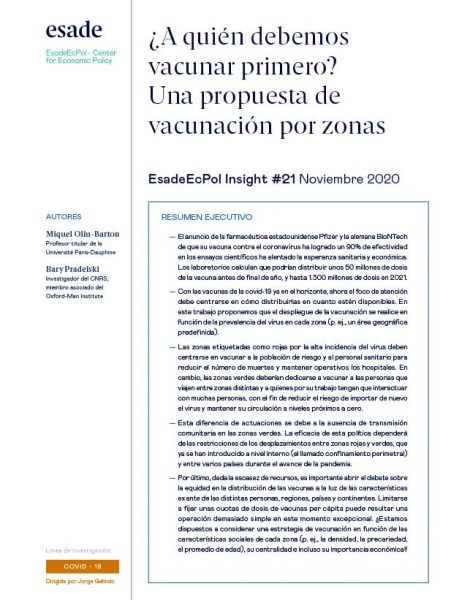
insight Covid-19
Who should be vaccinated first? A vaccination proposal by zones
Miquel Oliu-Barton, Bary Pradelski
11 Nov, 2020
EsadeEcPol Insight #21
This document is part of the Covid-19 research line, led by Jorge Galindo
Executive summary
- The announcement by the American pharmaceutical company Pfizer and the German company BioNTech that their coronavirus vaccine has achieved 90% effectiveness in scientific trials has raised health and economic hopes. The laboratories estimate that they could distribute some 50 million vaccine doses before the end of the year, and up to 1.3 billion doses by 2021.
With covid-19 vaccines already on the horizon, the focus must now be on how to handle distribution as soon as the doses become available. In this paper, we propose that the distribution of vaccines should be based on the prevalence of the virus in each zone (e.g. a predefined geographical area). - Areas labelled as red because of high incidence of the virus should focus on vaccinating the population at risk and health workers to reduce deaths and keep hospitals operational. Green zones should focus on vaccinating people who travel between different areas, and those whose jobs require them to interact with many people, in order to reduce the risk of re-importing the virus and keep its circulation near to zero.
- This difference in action is due to the absence of community transmission in green areas. The effectiveness of this policy depends on movement restrictions between red and green areas, which have already been introduced internally (perimeter containment), and between various nations as the pandemic progresses.
- Finally, given the scarcity of resources, it is important to start a discussion on equity in vaccine distribution given the ex-ante characteristics of different individuals, regions, countries, and continents. Setting per capita vaccine dose quotas may be too simple at this exceptional time. Are we prepared to consider a vaccination strategy based on the social characteristics of each area (e.g. density, precariousness, and average age), its centrality, and even its economic importance?

Read the full article:

Bary Pradelski
Associate professor of economics at CNRS and an associate member of Oxford-Man Institute
View profile


